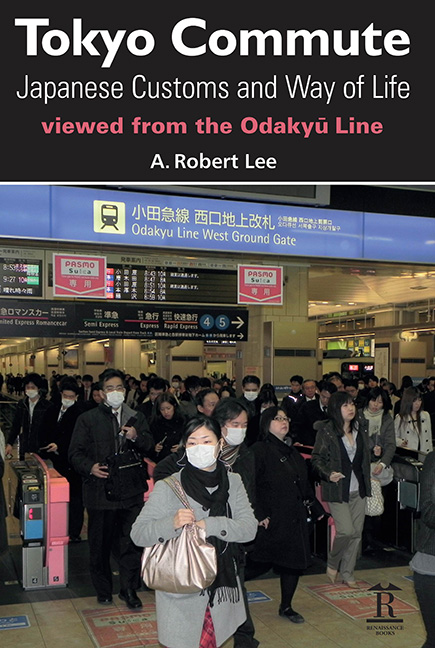Book contents
- Frontmatter
- Dedication
- Acknowledgements
- Contents
- 1 Odakyū-sen
- 2 Shinjuku Station
- 3 Shinjuku
- 4 Mukōgaoka-yūen North
- 5 Mukōgaoka-yūen South
- 6 Mukōgaoka-yūen Platform
- 7 January Monday
- 8 Odakyū Notables
- 9 Odakyū Line Sounds Familiar
- 10 Train Notices
- 11 Odakyū Commercials
- 12 February Tuesday
- 13 Odakyū Keitaispracht
- 14 By-line, Setagaya Line
- 15 March Wednesday
- 16 Odakyū Day-out Sendagi
- 17 Shimo-Kitazawa
- 18 Bicycle!
- 19 Odakyū Bike Interview – Toda-san
- 20 International Interlude via Narita Airport
- 21 Keitai Train Culture
- 22 April Thursday
- 23 Odakyū Tamagawa
- 24 Station Sights
- 25 Odakyū-sen, Yoyogi-Hachiman Eki
- 26 May Friday
- 27 Mukoōgaoka-yūen, Day for Night
- 28 Odakyū Day-out, Hakone
- 29 June Saturday
- 30 Odakyū Commercials
- 31 Odakyū Smokes
- 32 By-line, Nambu Line
- 33 Odakyū Bag Watch
- 34 Seijo Times
- 35 Odakyū Day-out, Yokohama
- 36 July Sunday
- 37 Odakyū Trains of Thought
- 38 Train Signs, Train Sounds
- 39 By-line, Tama Express
- 40 August Monday
- 41 Odakyū Day-out, Chiba
- 42 September Tuesday
- 43 Odakyū Lady-grooming
- 44 Odakyū and Near-Odakyū Women’s Hairday
- 45 Odakyū Evenings-out
- 46 October Wednesday
- 47 Odakyū Day-out, Ibaraki
- 48 Chikan! Odakyū Misbehaviour
- 49 November Thursday
- 50 Odakyū Blues
- 51 Odakyū Men’s Haircut
- 52 Odakyū Day-out, Ō-Sumo
- 53 December Friday
- 54 Odakyū Store
- 55 Odakyū Bookshelf
- 56 Last Train
- Glossary
16 - Odakyū Day-out Sendagi
Published online by Cambridge University Press: 26 May 2022
- Frontmatter
- Dedication
- Acknowledgements
- Contents
- 1 Odakyū-sen
- 2 Shinjuku Station
- 3 Shinjuku
- 4 Mukōgaoka-yūen North
- 5 Mukōgaoka-yūen South
- 6 Mukōgaoka-yūen Platform
- 7 January Monday
- 8 Odakyū Notables
- 9 Odakyū Line Sounds Familiar
- 10 Train Notices
- 11 Odakyū Commercials
- 12 February Tuesday
- 13 Odakyū Keitaispracht
- 14 By-line, Setagaya Line
- 15 March Wednesday
- 16 Odakyū Day-out Sendagi
- 17 Shimo-Kitazawa
- 18 Bicycle!
- 19 Odakyū Bike Interview – Toda-san
- 20 International Interlude via Narita Airport
- 21 Keitai Train Culture
- 22 April Thursday
- 23 Odakyū Tamagawa
- 24 Station Sights
- 25 Odakyū-sen, Yoyogi-Hachiman Eki
- 26 May Friday
- 27 Mukoōgaoka-yūen, Day for Night
- 28 Odakyū Day-out, Hakone
- 29 June Saturday
- 30 Odakyū Commercials
- 31 Odakyū Smokes
- 32 By-line, Nambu Line
- 33 Odakyū Bag Watch
- 34 Seijo Times
- 35 Odakyū Day-out, Yokohama
- 36 July Sunday
- 37 Odakyū Trains of Thought
- 38 Train Signs, Train Sounds
- 39 By-line, Tama Express
- 40 August Monday
- 41 Odakyū Day-out, Chiba
- 42 September Tuesday
- 43 Odakyū Lady-grooming
- 44 Odakyū and Near-Odakyū Women’s Hairday
- 45 Odakyū Evenings-out
- 46 October Wednesday
- 47 Odakyū Day-out, Ibaraki
- 48 Chikan! Odakyū Misbehaviour
- 49 November Thursday
- 50 Odakyū Blues
- 51 Odakyū Men’s Haircut
- 52 Odakyū Day-out, Ō-Sumo
- 53 December Friday
- 54 Odakyū Store
- 55 Odakyū Bookshelf
- 56 Last Train
- Glossary
Summary
Time for a small literary trip. Odakyūout of Mukōgaoka-yūen down to Yoyogi-Uehara. Change to the Chiyoda Line. And on through first to Nezu-eki, and then, Sendagi-eki.
Ogai Mori, or in transliterated Japanese, Mori Ōgai. Real name was Mori Rintarō (1862-1922). Hugely important Meiji-era notable, a physician who rose to become Surgeon-General of the Japanese Army, a major medical presence sent to Manchuria in the Sino-Japanese (1894) and the Russo-Japanese War (1904–1905). Trained in Confucian classics, and across a four-year stay at various universities in Europe, mainly Germany. Learned both German and Dutch. Above all, an author to rank with Natsume Sōseki. Novels, stories, histories, essays.
In March 1889, he married Akamatsu Toshiko, daughter of an Admiral, and moved into her family house – a house still standing but now maintained as part of the Suigetsu Hotel Ohgaisu (the latter phrase also Ogai-sou or Ogai residence/homestead). He there wrote, or began, his classic story Maihime (1890), usually translated The Dancing Girl, set in Germany and with its ill-starred drama of damaged love. The abandonment of the dancer of the title who carries her child by Toyotarō Ota: he opts to return to Japan without her. The work has lasted. Mori's marriage did not. Less than a year and he and Toshiko-san were divorced. Ars longa, vita brevis kind of comes to mind.
Few later works of fiction better confirm Mori's imaginative grace than Gan (first published serially in twelve parts 1911-1913) and translated into English as The Wild Geese. Lovely, affecting novella of a woman who allows herself to become the mistress of a moneylender in order to help her ailing father but who falls for a medical student, the very object of desire. Around this triangle Mori creates a busy, circumstantial word of late Edo becoming Meiji Japan. For his last two or so decades Mori lived in Sendagi, in a house which served as a salon that included the novelists Natsume Sōseki and Kafu Nagai and the poets Takuboku Ishikawa and Mokichi Saito. That house was demolished, a successor built. But what remains is the original wall with the kanji for View, Tide, Tower, an assumed reference to the possibility of being able to see the Tokyo Bay in the distance.
- Type
- Chapter
- Information
- Tokyo CommuteJapanese Customs and Way of Life Viewed from the Odakyū Line, pp. 65 - 67Publisher: Amsterdam University PressPrint publication year: 2011



